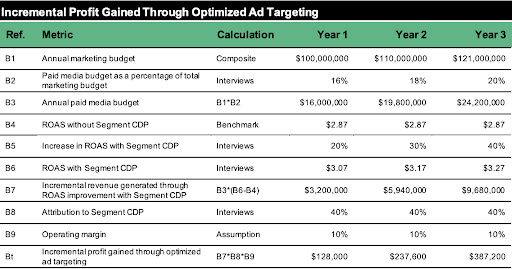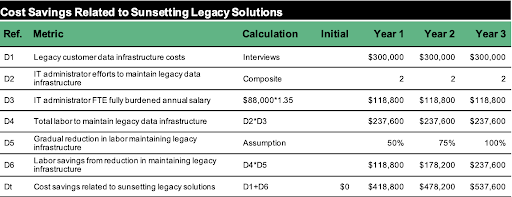How to Maximize the Time to Value of a Customer Data Platform
To better understand how to maximize the time to value of a customer data platform, we compiled insights from five anonymized organizations with experience using Segment.
To better understand how to maximize the time to value of a customer data platform, we compiled insights from five anonymized organizations with experience using Segment.
As digital adoption accelerates – online shopping, streaming, remote work – the world today is more connected than ever before.
Yet understanding consumer behavior across various channels and devices continues to be a challenge for organizations, big and small. With economic uncertainty on the horizon, failing to understand and engage with customers on the digital channels they prefer is a risk most businesses can’t afford to take.
To address this challenge head-on, savvy business leaders are turning to a timely solution: a customer data platform (CDP).
A CDP (like Twilio Segment) provides the data foundation and APIs that allow organizations to more easily ingest, clean, and manage their customer data.
To better understand the costs and benefits associated with this investment, we compiled insights from five anonymized organizations with experience using Segment.
By interviewing key leaders at these businesses, we were able to uncover the tangible business impact a customer data platform delivered for each over a three-year span.
Time to value (TtV) is the time it takes to realize the value you were expecting from a product. In the world of SaaS, this value realization moment is also referred to as the “aha moment”.
As the leading customer data platform, we’ve helped thousands of businesses reach their aha moment with unified data and a complete view of the customer.
Unlike other tools, the value derived from a customer data platform is not limited to one particular area of an organization.
With a CDP, marketing teams can develop more personalized campaigns and deliver better ROI through optimized ad targeting; product teams gain a single view of their customer, and engineering teams can reduce time spent on labor-intensive data management activities.
However, just like any SaaS platform, it’s important to follow best practices to maximize the return on your investment and minimize the time spent realizing it.
Here are four steps you can follow to get the most out of your customer data platform.
Personalization, driven by detailed and actionable data embedded in a customer profile, helps organizations make meaningful connections with the right customer at the right time.
Before implementing a CDP, most businesses lack a unified location for customer data. As a result, disparate data sources and disconnected systems result in an incomplete view of customers’ relevant needs and preferences.
Because of these challenges, many organizations can’t fully employ segmentation and personalization within their marketing campaigns.
With Segment, the customers we interviewed reported a holistic, singular view of the customer and greater confidence in leveraging segmentation and personalization to deepen customer engagement.
The results, averaged over a 3-year period, for these Segment customers demonstrate how personalization with high-quality customer data can deliver real business impact:
50% increase in open rates for personalized emails sent with Segment
20% average improvement in conversion rates
40% increase in click-through rates for personalized emails
Building detailed customer profiles and targeted audiences based on historical purchase data, customers’ expressed preferences, and tracked behavioral patterns online is key to a successful paid advertising strategy.
Before Segment, our interviewed organizations struggled to gain a complete picture of their customers based on personal preferences and behavioral patterns, making strategic audience-building and ad targeting difficult.
A customer data platform provides the necessary tools to ingest, clean, and manage the customer data that is fed into customer profiles and subsequently, the ability to develop highly targeted audiences.

Once again, the average results over a 3-year period show how Segment helped these organizations do more with less advertising spending:
Improved advertising efficiency
40% increase in return on ad spend
$9.6 million total incremental revenue generated
Another notable benefit of a customer data platform is the optimization of organizational spend by reallocating higher-cost resources to higher-value activities.
The Head of Growth for a consumer electronics organization we interviewed aptly describes this data processing and management transformation:
We had to go from chaos to order, and Segment helped us do that.
Without a CDP, data management activities can be labor- and resource-intensive due to a heavy manual lift for common tasks, including ingesting new data sources; performing ETL; establishing connectivity to destination applications; monitoring data, and managing data.
Through Segment, data engineers can spend significantly less time on labor-intensive data processing and management tasks which frees up valuable engineering resources for more impactful work.
A few of our customers reported that they experienced cost savings through the gradual decommissioning of their legacy data systems whose capabilities were either redundant with or less effective than a customer data platform.
Before partnering with Segment, these organizations used a variety of custom, in-house-built solutions to ingest new data and connect to downstream tools.
However, with a CDP in place, all costs associated with maintaining legacy tools, such as licensing, third-party fees, and internal labor efforts, were eliminated over a three-year timespan.
Eliminating technical redundancies also allowed these organizations to more efficiently reallocate resources for net cost savings and strengthen organizational connectivity by minimizing other teams’ efforts interfacing with legacy solutions.

There you have it. Four simple strategies to maximize the time to value of your customer data platform.
Although there is much we can learn from these organizations, the main takeaway is this – clean, actionable customer data, connected to all your downstream tools, is an effective way to drive business impact across the organization.
As the macroeconomic environment continues to shift, there is no better time to invest in a solid data foundation that will deliver value for years to come.

Our annual look at how attitudes, preferences, and experiences with personalization have evolved over the past year.